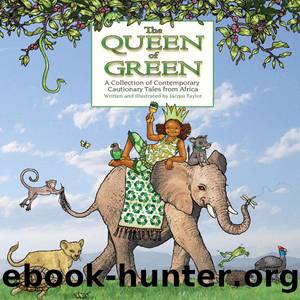The Queen of Green by Jacqui Taylor

Author:Jacqui Taylor
Language: eng
Format: epub
Tags: Author and illustrator Jacqui Taylor has designed The Queen of Green for children, as well as all those involved with children, to teach them what it means to ‘go green’ and how they can assist in taking better care of planet earth. Through the medium of contemporary verses, marvellous illustrations, tips and facts, she goes straight to the heart of the matter – we need to love the earth. She wants children to realise that they can be a part of the solution, rather than the problem, and have fun at the same time. Concepts such as ‘global warming’ and ‘climate change’ are explained in a way that children will understand. It’s a must for every child; their parents, grandparents, teachers and child carers might discover that they too can learn something new!
ISBN: 978-1-43230-240-5
Publisher: Penguin Random House South Africa
Published: 2013-03-22T16:00:00+00:00
EARTH
Every day we work, play, eat, sleep and live on Earth without thinking much about whatâs on it or inside it!
The soil beneath our feet sustains all living things. To understand this, we need to look at the âFood Chainâ or âFood Webâ. Energy is passed from one living thing to another in a complex chain or web.
There are four main parts to this chain: 1) The Sun provides the energy for everything on Earth. 2) Producers are green plants that make their own food by capturing the sunâs energy and by using water and nutrients from the soil. They make up the biggest part of the food chain or web. 3) Consumers are every living thing that eats something else. They include herbivores (animals that eat plants), carnivores (animals that eat other animals), omnivores (animals that eat both plants and animals), parasites (animals that live off of other organisms), and scavengers (animals that eat dead animal carcasses). 4) Decomposers are mainly bacteria and fungi that convert dead organic matter into gases such as carbon and nitrogen to be released back into the air, soil, or water. Mushrooms and moulds play a very important role. Without these decomposers, there would be trash everywhere! They recycle the nutrients to be used again by producers.
Only just over 10% of the 148.94 million km2 of land on Earth is what we call âarableâ. This means that it can be used for growing crops or forests. Much of this arable land is lost when natural vegetation is stripped away by man, overgrazing or fire, and the topsoil is washed away by water or wind. This is âerosionâ and can eventually turn what was a fertile area into a desert.
Soil is also affected by chemicals such as fertilisers and pesticides used on crops. These chemicals can damage the balance of the soil and be harmful to humans, animals and plants.
Another way that soil becomes contaminated is through landfills. When your garbage is collected it is taken to the city dump where it is tipped into a hole that has earth graded over it. Not everything that goes into our garbage dumps is biodegradable ~ that is, it canât easily be absorbed back into the earth. Dangerous chemicals and pollutants can leach into the groundwater, making it unsafe to drink and poisonous for fish, birds and other animals, too. Landfills also take up huge amounts of space. For this reason we need to reduce, re-use and recycle whatever we can so that we donât end up burying ourselves under our own rubbish!
WHY DO WE NEED GOOD SOIL?
We eat vegetables that are grown in the ground and products that come from animals that have eaten things grown in the ground. That is why it is important to protect the soil and try our best not to poison it. Many people have now chosen to grow and/or buy and eat organic food. Organic production means using no artificial fertilisers or pesticides, and adding no chemical additives into stockfeed;
Download
This site does not store any files on its server. We only index and link to content provided by other sites. Please contact the content providers to delete copyright contents if any and email us, we'll remove relevant links or contents immediately.
The Take Back of Lincoln Junior High by Roseanne Cheng(96)
Jamie (A Novel) by L. D. Lapinski(63)
One Is a Lot (Except When It's Not) by Muon Thi Van(61)
Annie Aardvark, Mathematician by Suzie Olsen(59)
The Birds of Covey Island by Robert Robertson & Marian Robertson(59)
The Queen of Green by Jacqui Taylor(47)
The Secret of Death Trap Mine by Craig A. Hart & Alicia Hansen & Jonathan Cooke(46)
Indian Tales by Romila Thapar(40)
What Is Your Favorite Color? by Joanie O. McClinton(25)
